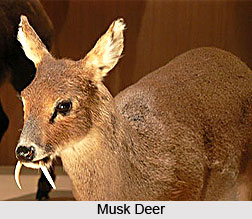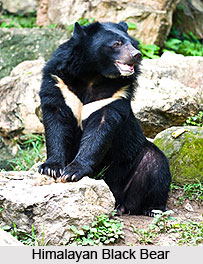 Dachigam Wildlife Sanctuary was set up to protect the rare wild animals like the brown bears and Musk Deers which are rarely found in the hilly regions of Jammu and Kashmir. It is one of the richest wild life sanctuaries located at a distance of 22 kms from Srinagar. This sanctuary spreads over an area of 141 sq. km. The sanctuary has been one of the biggest attractions for the tourists of Jammu and Kashmir who visit the sanctuary to explore the rich and wide varieties of wildlife. The topography, climate and vegetation of the area have been the biggest gift of nature which supports the animal life there. The sanctuary which is located at a height that spans between 5500ft and 14000 ft. It forms a major part of Dal Lake`s catchments area.
Dachigam Wildlife Sanctuary was set up to protect the rare wild animals like the brown bears and Musk Deers which are rarely found in the hilly regions of Jammu and Kashmir. It is one of the richest wild life sanctuaries located at a distance of 22 kms from Srinagar. This sanctuary spreads over an area of 141 sq. km. The sanctuary has been one of the biggest attractions for the tourists of Jammu and Kashmir who visit the sanctuary to explore the rich and wide varieties of wildlife. The topography, climate and vegetation of the area have been the biggest gift of nature which supports the animal life there. The sanctuary which is located at a height that spans between 5500ft and 14000 ft. It forms a major part of Dal Lake`s catchments area.
This sanctuary is divided into two parts which is usually demarcated into Upper Dachigam which is often visited in the month of May and August; and Lower Dachigam which is visited during the months of September to December. The sanctuary was upgraded into Dachigam National Park in 1981 under the State Government of Jammu and Kashmir which provides special permission to its visitors. The sanctuary has some restricted places which are prohibited for tourists.
Dachigam Wildlife Sanctuary is famous for some rare variety of flora and fauna which is preserved by the forest authorities. Surrounded with high mountain ridges the sanctuary is located amidst the western Himalayas. The region includes a combined topography which consists of sloping grasslands to sharp rocky outcrops along with cliffs. The national park is covered with coniferous forests with alpine pastures, surging meadows, waterfalls and scrub vegetation. The grassland is mainly covered with beautiful and attractive flowers that exhibit one of the most enchanting views of the area. This is surrounded by the Masar Lake which flows from the centre of the sanctuary. The sanctuary also provides an opportunity for fishing which entertains the tourists to a great extend. Dachigam wildlife sanctuary also include some prominent floras like Oak, Apricot, Poplar, Wild Cherry, Birch, Walnut, Pear, Elm, Plum, Apple, Chestnut, Willow, Chinar, Pine and Peach.
 Along with this Dachigam Wildlife Sanctuary is more popular for the rare collection of fauna which includes species of Musk Deer, Langur, Himalayan Brown Bear, Himalayan Black Bear, Leopard, Himalayan Marmot, etc. The National park has some rare collection of fruits which are mainly eaten by the Himalayan black beer and Brown bears. Among all animals the biggest attraction of the sanctuary is the rare species of Hungal which is also known as Kashmir Stag. Along with the species of carnivorous animals, Dachigam is also known for the migratory birds that visit the area in the months of March and remain till May. Most prominent migratory birds like Bearded Vulture (Lammergeier), Golden Eagle, Red-billed Chough, Yellow-billed Chough, Yellow-billed Blue Magpie, Streaked Laughingthrush, Tickell`s Thrush, Black and Yellow Grosbeak, Himalayan Monal, Koklass Pheasant, Kashmir Flycatcher, Dark-sided Flycatcher, Ultramarine Flycatcher, Green-backed Tit, Himalayan Bulbul, Brownish-flanked Bush Warbler, Scaly-bellied Woodpecker, Paradise Flycatcher, Tytler`s Leaf-Warbler, etc. are often found in this national park
Along with this Dachigam Wildlife Sanctuary is more popular for the rare collection of fauna which includes species of Musk Deer, Langur, Himalayan Brown Bear, Himalayan Black Bear, Leopard, Himalayan Marmot, etc. The National park has some rare collection of fruits which are mainly eaten by the Himalayan black beer and Brown bears. Among all animals the biggest attraction of the sanctuary is the rare species of Hungal which is also known as Kashmir Stag. Along with the species of carnivorous animals, Dachigam is also known for the migratory birds that visit the area in the months of March and remain till May. Most prominent migratory birds like Bearded Vulture (Lammergeier), Golden Eagle, Red-billed Chough, Yellow-billed Chough, Yellow-billed Blue Magpie, Streaked Laughingthrush, Tickell`s Thrush, Black and Yellow Grosbeak, Himalayan Monal, Koklass Pheasant, Kashmir Flycatcher, Dark-sided Flycatcher, Ultramarine Flycatcher, Green-backed Tit, Himalayan Bulbul, Brownish-flanked Bush Warbler, Scaly-bellied Woodpecker, Paradise Flycatcher, Tytler`s Leaf-Warbler, etc. are often found in this national park
.
Thus Dachigam Wildlife Sanctuary is one of the most attractive tourist spots of Jammu and Kashmir valley which is encircled with such roadways that help the tourists to reach every corner of the forest region. With the rare collection of Himalayan Beers and other rare animals, this sanctuary is considered to be one of the most valuable sanctuary that preserves rare species in such an altitude.






